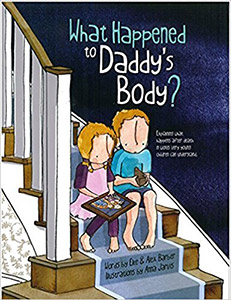This is a story told by Alex, whose daddy died suddenly when he was three. Alex often thinks about Daddy, and sometimes he asks questions, which his Mummy always tries to answer honestly.
Alex asks Mummy what happened to Daddy’s body after he died. Mummy asks Alex to remember Daddy’s funeral at the crematorium, and explains how a coffin and a dead body are burned after the ceremony.
Mummy tells Alex that after the cremation, just ashes are left. She also mentions that some people are buried rather than cremated. The family take a walk to the woods, where Mummy uses the surroundings to explain how buried bodies break down in time and slowly feed the plants and trees.
Alex has a sad moment at his fifth birthday party, thinking about Daddy not being there, but he looks around at all his friends and family – including Mummy’s new boyfriend, John and his children. John is not Alex’s daddy, he says. But he likes him a lot.
One day, Mummy explains to Alex that she is going to a special place to scatter Daddy’s ashes, and by doing this they can help plants and trees to grow. Alex becomes upset. Mummy cuddles him, and explains that they will still talk about Daddy every day. They will always love him.
Alex misses his Daddy every day, but with Mummy, Olivia and all of John’s children, he has a lot of fun. Mummy tells him it’s okay to be sad. But it’s okay to be happy, too. And, says Alex, they are.
This beautifully produced book bravely tackles the questions that a very young child will undoubtedly have when a loved one dies. The text is cleverly thought out, and the exquisite illustrations match the message on each page perfectly, resulting in a book that is full of facts, but also full of love. “What Happened to Daddy’s Body?” is the perfect follow-up to Alex and Elke’s first book, “Is Daddy Coming Back in a Minute?”. It deals with the hardest of situations in a unique, honest and heartfelt way that will resonate with children like Alex who are going through a bereavement.
 This is a frank and lovingly written book, explaining clearly what happens to someone’s body when they die. It provides young children with a means to understand what happens after death, whilst reassuring them with the message that life goes on for those left behind.
This is a frank and lovingly written book, explaining clearly what happens to someone’s body when they die. It provides young children with a means to understand what happens after death, whilst reassuring them with the message that life goes on for those left behind.
